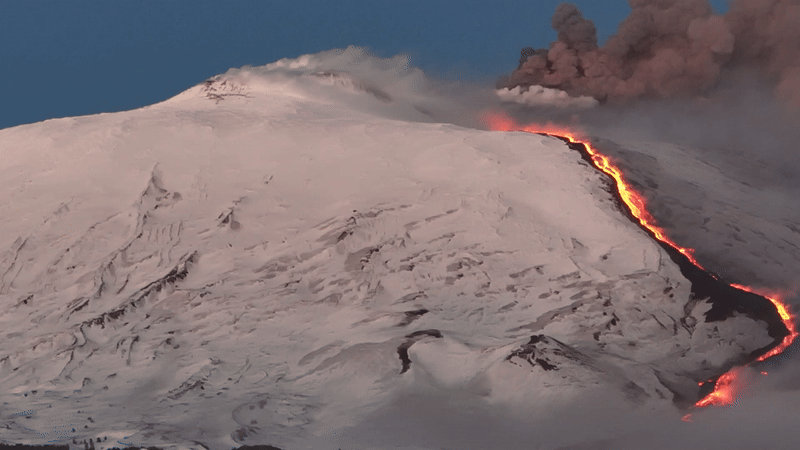Spectacle of Nature: Lava Meets Snow on Mount Etna’s Fiery Slopes
In a breathtaking display of nature’s artistry, the iconic Mount Etna has recently captivated onlookers as its molten lava flows dramatically contrast with the pristine white snow blanketing the landscape. This extraordinary phenomenon not only draws tourists and photographers but has also piqued the interest of scientists eager to study the implications of such volcanic activity on climate interactions. As the world watches, the fiery slopes of Mount Etna reveal a stunning spectacle that underscores the dynamic interplay between geological forces and weather patterns.
The Magnificence of Mount Etna
Mount Etna, located on the east coast of Sicily, Italy, is one of the most active volcanoes in the world. Its eruptions have been documented for centuries, making it a focal point for both geological research and tourism. With a height of over 3,300 meters, it towers above the surrounding landscape and is often capped with snow, particularly during the winter months. The contrast of lava and snow is not just a visual delight; it also serves as a vivid reminder of the planet’s volatile nature.
The Current Event: Lava Flows and Snow
Recently, as winter blankets Sicily in snow, Mount Etna has erupted, sending streams of glowing lava cascading down its slopes. This striking juxtaposition of fiery orange and deep white creates a surreal landscape, attracting visitors and scientists alike. The lava, which can exceed temperatures of 1,000 degrees Celsius, flows through the snow, creating steam and adding to the atmospheric wonder of the scene. This spectacle is particularly fascinating because it illustrates the unpredictable relationship between volcanic activity and climatic conditions.
Scientific Observations and Implications
As scientists closely monitor Mount Etna’s activity, they are particularly interested in how this volcanic eruption interacts with the surrounding climate. The phenomenon of lava meeting snow raises several questions about:
- Volcanic Gas Emissions: Eruptions release gases such as sulfur dioxide, which can influence weather patterns and air quality.
- Melting Snow: The heat from the lava can rapidly melt surrounding snow, affecting local ecosystems and water sources.
- Geological Stability: Understanding how eruptions impact the stability of slopes can help predict future volcanic activity.
Researchers from the National Institute of Geophysics and Volcanology (INGV) have been deploying advanced monitoring equipment to gather data on the current eruptions. This includes seismic sensors, thermal cameras, and satellite imagery, all aimed at providing a comprehensive understanding of the dynamics at play.
Climate Interactions: A Double-Edged Sword
The interaction between lava and snow is not merely aesthetic; it carries significant implications for our understanding of climate systems. Volcanic eruptions can temporarily cool the atmosphere by injecting ash and gases into the stratosphere, which reflects sunlight. Conversely, the heat generated by lava can lead to localized warming, creating microclimates that may have unforeseen effects on the surrounding flora and fauna.
Moreover, the melting of snow due to volcanic heat can lead to increased runoff into rivers, potentially causing flooding in lower areas. This dual effect of warming and cooling complicates our understanding of climate dynamics in volcanic regions.
A Tourist’s Paradise
For tourists, the sight of lava meeting snow offers an unparalleled opportunity to witness nature’s power firsthand. Tour operators have begun organizing excursions to safely observe this phenomenon, allowing visitors to experience the fiery display while maintaining a safe distance. The combination of snow-covered landscapes and glowing lava creates stunning photographic opportunities, drawing photographers and nature enthusiasts from around the globe.
Safety First: Guidelines for Observing Volcanic Activity
While the spectacle is awe-inspiring, it is crucial for visitors to adhere to safety guidelines when exploring areas near active volcanoes. Here are some tips for observing Mount Etna safely:
- Stay Informed: Always check local advisories and volcanic activity reports before planning your visit.
- Follow Guides: Engage with certified tour guides who understand the geological landscape and safety protocols.
- Wear Appropriate Gear: Dress warmly and wear sturdy footwear to navigate potentially icy and rugged terrain.
Conservation and Respect for Nature
As we marvel at the spectacle of lava meeting snow, it is essential to remember the importance of conservation. The ecosystems surrounding Mount Etna are delicate and can be easily disrupted. Respecting guidelines and preserving the natural environment should be a priority for all visitors and researchers.
Moreover, understanding the cultural significance of Mount Etna to the local communities is vital. The volcano has shaped the history, economy, and identity of the Sicilian people. Engaging with local traditions and respecting their connection to the land enhances the experience of witnessing this magnificent spectacle.
Conclusion: A Living Laboratory
Mount Etna’s recent display of lava and snow is a vivid reminder of the Earth’s dynamic nature. As scientists continue to study this phenomenon, they gain valuable insights into the interplay between volcanic activity and climate. For tourists and nature lovers, it presents an opportunity to witness one of the planet’s most extraordinary spectacles. As we engage with this natural wonder, let us do so with respect, curiosity, and a commitment to understanding the intricate balance of our environment.
In the end, the spectacle of nature that unfolds on Mount Etna’s fiery slopes is not just a visual feast—it’s a captivating story of the Earth’s geological processes, climate interactions, and the enduring power of nature. Whether you’re a scientist, a photographer, or simply an admirer of the natural world, this event serves as a reminder of the beauty and complexity of our planet.
See more Your Daily Weather



